3.10 Psoroptic Mange – Large Animals
Learning Objectives
- Know if psoroptic mange is a zoonotic disease.
- Know the host specificity of the mites.
- Learn how long the mites live off the host.
- Describe the clinical signs of the disease in cattle, sheep, goats and horses.
- Know the animal species that it is a reportable disease.
- Learn how to manage psoroptic mange.
-
General Considerations
- Psoroptic mange is a devastatingly pruritic dermatitis of cattle and sheep and a frequent cause of otitis externa in goats and horses.
- The mites are non-burrowing and feed on tissue fluids.
- The life cycle is completed on the host in 10 to 12 days.
- The mites can survive off the host for at least 2 weeks.
- Transmission is by direct contact with the affected animal and indirect contact via contaminated environment and fomites.
- Psoroptic mange is not a zoonotic disease.
- The long-held host specificity of the mites is an area of controversy because psoroptic mites were transmitted from rabbits and goats to sheep.
-
Bovine Psoroptic Mange
- Cause:
- Psoroptes ovis.
- Clinical Signs:
- More common in Western and Central United States.
- Clinical signs are more severe in fall and winter. Mite populations are usually much smaller in spring and summer and confined to body folds, especially the perineum, inguinal region, and interdigital areas.
- Intensively pruritic dermatitis usually starts at the shoulders, withers and tail head.
- Generalized skin involvement can occur.
- Non-follicular papules and pustules, crusts, scales, excoriations and alopecia are seen. The skin becomes lichenified in chronic cases.
- Severely affected animals may become weak and emaciated and die.
- Cause:
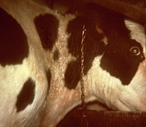
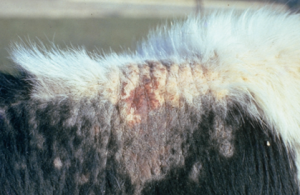
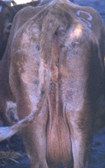
-
- Diagnosis:
- History and clinical signs.
- Multiple skin scrapings. Body mites are usually easy to find.
- Treatment:
- It is a REPORTABLE disease. Call state veterinarian.
- All in-contact animals should be treated.
- Ivermectin is very effective and has been approved by the U.S. Department of Agriculture to treat psoroptic mange in cattle. A single subcutaneous injection of 200 µg/kg (0.2 mg/kg) can result in mite eradication after 20 days of treatment.
- A study showed that a long-acting injectable formulation of ivermectin (3.15%) given subcutaneously, once, at 0.63 mg/kg (1ml/50kg) provided a prophylactic effect against Psoroptes ovis infestation for at least 56 days post-application. On the other hand, 1% injectable doramectin given also subcutaneously at a single dosage of 0.2 mg/kg (1ml/50kg) provided a prophylactic effect of no more than 35 days post-treatment.
- Diagnosis:
-
Caprine Psoroptic Mange
- Cause:
- Psoroptes cuniculi.
- Clinical Signs:
- It is a common cause of ear mites in goats.
- Dairy goats are more often affected and animals as young as 10 days of age can have psoroptic mange.
- Some goats appear to be clinically normal but carry the mites.
- Others show head shaking and scratching of the pinnae with the back foot. The ear canals have variable degrees of cerumen and scales accumulation.
- Self-inflicted alopecia and crusting of the external pinnae can also occur.
- Severe infestations can cause otitis media and interna and the disease spreads to other body regions with yellow-brown crusts developing over the poll, face, pasterns and interdigital areas.
- Cause:
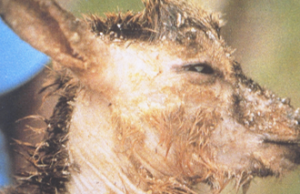
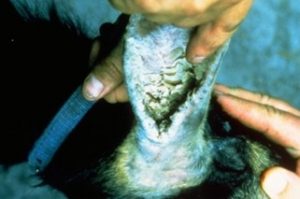
-
- Diagnosis:
- History and clinical signs.
- Mites can be difficult to find in the ear canal. A microscopic examination of the material collected from deep within the ear canal is necessary to demonstrate the mites. Sedation is often necessary to examine the ears adequately.
- Mites are generally easy to find via skin scrapings in affected body regions other than the ear canals.
- Treatment:
- It is not reportable.
- Clean the ear canals thoroughly and treat twice weekly for 3 weeks with the following otic acaricides:
- One part rotenone (Canex; Pittman-Moore, Inc) in three parts mineral oil.
- Thiabendazole (Tresaderm; Merial).
- When lesions are present in body regions other than the ear canals, apply total body dips or sprays with the following parasiticides at least twice at 14-day intervals:
- 0.25% coumaphos.
- 0.2% trichlorfon.
- 0.5% malathion.
- 2% lime sulfur.
- Single subcutaneous injection of ivermectin at 200 µg/kg (0.2 mg/kg).
- Treat all in-contact animals.
- Diagnosis:
-
Equine Psoroptic Mange (2 forms)
- Causes and Clinical Signs:
- Psoroptes equi.
- It causes body mange.
- The disease caused by Psoroptes equi is reportable.
- Pruritus is the main sign and it tends to occur in cooler months.
- The disease begins as papules and alopecia on the head, base of the mane and tail base. It can progress to become generalized is some horses.
- Continued self-trauma results in crusts, erosions, and lichenification.
- Psoroptes cuniculli.
- Some animals can be clinically normal.
- Others show pruritic otitis externa.
- Clinical signs include head shaking and ear rubbing.
- Thick greasy crusts build up in the ear canal.
- Mites can occasionally spread to the face, neck and body.
- The disease caused by Psoroptes cuniculli is not reportable.
- Psoroptes equi.
- Causes and Clinical Signs:
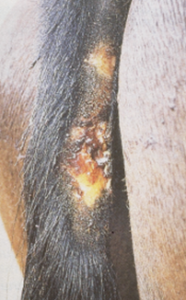
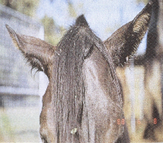
-
- Diagnosis:
- History and clinical signs.
- Mites can be difficult to find in the ear canals. Microscopic examination of the material collected from deep within the ear canal is necessary to demonstrate the mites. Sedation is often necessary to examine the ear canals effectively.
- Mites are generally easy to find via skin scrapings in affected body regions other than the ear canals.
- Treatment:
- Ivermectin: 200 µg/kg (0.2 mg/kg) administered orally for two doses at 14-day intervals is effective for both forms.
- Moxidectin: 2% oral gel at 0.4 mg/kg administered orally once.
- Treat all in-contact animals.
- Diagnosis:
-
Ovine Psoroptic Mange
- Cause:
- Psoroptes ovis.
- Clinical Signs:
- Psoroptic mange is a disease of major economic importance to the sheep industry.
- It has been eradicated from most developed countries.
- The disease becomes clinically apparent in the fall and winter.
- During the summer months, infections may become latent and mites reside in the body folds until the following fall.
- Ovine psoroptic mange is a debilitating and damaging condition caused by a hypersensitivity reaction to the fecal material of the parasitic mite.
- The chief clinical sign is intense pruritus.
- Woolen areas are primarily affected and the wool of affected sheep develops a jagged appearance.
- The disease is characterized by exuberant yellowish scabs, yellow-stained fleece, wool loss, head tossing, bleeding wounds and loss of condition.
- Infestation may sometimes be limited to the external auditory meatus. This may cause head shaking and rubbing/scratching of the affected ear resulting in aural hematoma, inflammation and excoriation of the pinna and base of the ear.
- In severe cases, loss of condition may be extreme resulting in depression, emaciation and death.
- The disease is highly contagious.
- Mites concealed within hidden folds or crevices in clinically normal sheep may survive for 2 years, thus providing a further source of transmission.
- Infection may cause low reproductive rate and weight loss or reduced weight gain. Moreover, the extra acaricide and labor costs cause an economical burden to the farmer.
- Diagnosis:
- History and clinical signs.
- Mites can be difficult to find in the ears canals. Microscopic examination of the material collected from deep within the ear canal is necessary to demonstrate the mites. Sedation is often necessary to examine the ear canals effectively.
- Mites are generally easy to find via skin scrapings in affected body regions other than the ear canals.
- Treatment:
- Psoroptic mange is a reportable disease in sheep. Call state veterinarian.
- Vat-dipping. Dipping is most effective if performed within 2 weeks after shearing and must be repeated in 10 to 14 days.
- 0.3% coumaphos; 0.15 to 0.25% phosmet; 0.03 to 0.1% diazinon; 2% hot lime sulfur can be effective.
- A study showed that a new formulation of deltamethrin made with 2-propylene glycol l-methyl ether acetate (AMP) was effective to treat psoroptic mange in sheep when applied as a 5% solution mixed in water twice at 10-day intervals. No parasites were seen 14 days after treatment.
- Two subcutaneous injections of ivermectin given at the dosage of 0.2 mg/kg, 7 days apart has been shown to be effective.
- A study showed that doramectin given at 0.3 mg/kg was effective as a single subcutaneous injection. Doramectin has a longer period of activity than ivermectin.
- When used prophylactically, a single injection of long-acting 2% moxidectin can provide protection for up to 60 days. Diazinon plunge dip has been reported to confer protection for up to 63 days (a license is required to purchase diazinon in the USA).
- Treat all in-contact animals.
- Cause:
Important Facts
- Psoroptic mange is associated with a devastatingly pruritic dermatitis in cattle and sheep and with otitis externa in goats and horses.
- In cattle and sheep, the disease becomes clinically apparent in the fall and winter. In the spring and summer, smaller mite populations reside in body folds.
- It is not a zoonotic disease.
- It is reportable in sheep and cattle and the body form is reportable in horses.
- Mites can live off the host for at least 2 weeks.
- Ivermectin is likely to be an effective treatment in all species.
- Treat all in contact animals.
References
Bates PG, Groves BA, Courtney SA et al. Control of sheep scab (Psoroptes ovis) on artificially infested sheep with a single injection of doramectin. Vet Rec 1995; 137:491-492.
Bridi AA, Carvalho LA, Cramer LG et al. Efficacy of a long-acting formulation of ivermectin against Psoroptes ovis (Hering, 1838) on cattle. Vet Parasitol 2001; 97:277-283.
Cadiergues MC, Laguerre C, Roques M et al. Evaluation of the bioequivalence of two formulations of deltamethrin for treatment of sheep with psoroptic mange. Am J Vet Res 2004; 65(2):151-154.
Losson BJ. Sheep psoroptic mange: An update. Vet Parasitol 2012; 189: 39-43.
Nixon EJ, Vineer HR, Wall R. Treatment strategies for sheep scab: An economic model of farmer behaviour. Prev Vet Med 2017; 137: 43-51.
Osman SA, Hanafy A, Maer SE. Clinical and therapeutic studies on mange in horses. Vet Parasitol 2006; 141: 191-195.
Scott DW. Parasitic Diseases. In: Large Animal Dermatology. Philadelphia, PA: W.B. Saunders, 1988; 207-215.
Van den Broek AH, Huntley JF. Sheep scab: the disease, pathogenesis and control. J Comp Pathol 2003; 128(2-3): 79-91.

